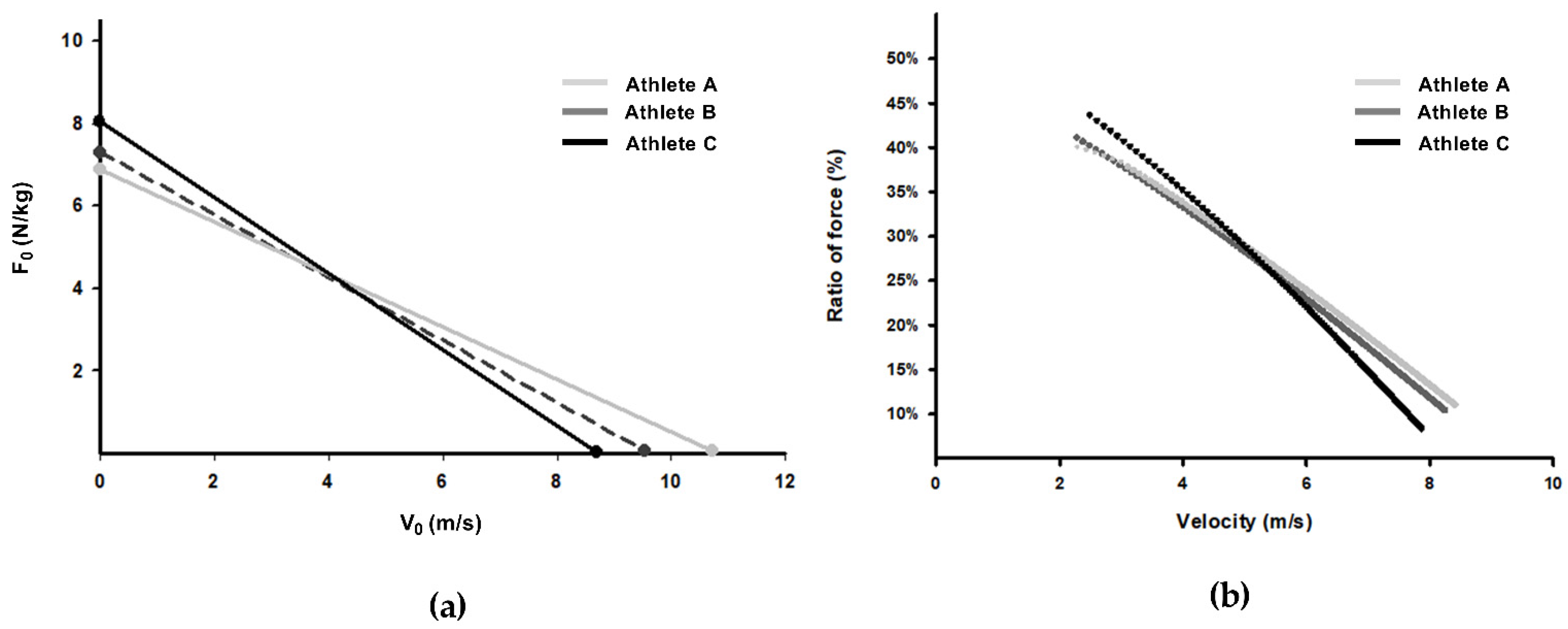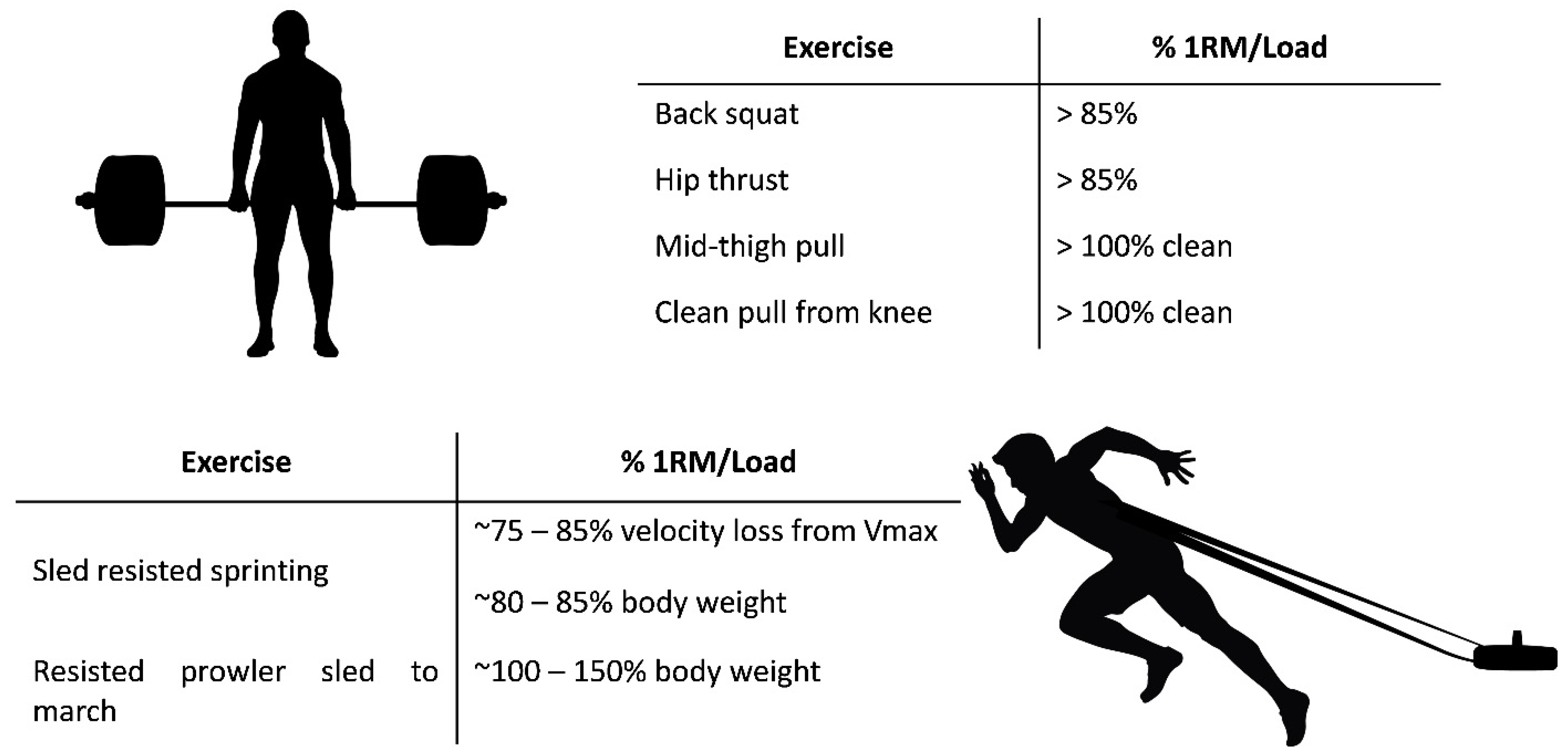Maximizing Acceleration and Change of Direction in Sport: A Case Series to Illustrate How the Force-Velocity Profile Provides Additional Information to That Derived from Linear Sprint Time
Abstract
1. Introduction
2. Materials and Methods
2.1. Procedures
2.1.1. Sprint FV Profile Test
2.1.2. Change of Direction Test
3. Results
4. Discussion
5. Conclusions
Author Contributions
Funding
Institutional Review Board Statement
Informed Consent Statement
Data Availability Statement
Conflicts of Interest
References
- Salaj, S.; Markovic, G. Specificity of Jumping, Sprinting, and Quick Change-of-Direction Motor Abilities. J. Strength Cond. Res. 2011, 25, 1249–1255. [Google Scholar] [CrossRef] [PubMed]
- Brughelli, M.; Cronin, J.; Levin, G.; Chaouachi, A. Understanding change of direction ability in sport: A review of resistance training studies. Sport Med. 2008, 38, 1045–1063. [Google Scholar] [CrossRef]
- Loturco, I.; Pereira, L.A.; Freitas, T.T.; Alcaraz, P.E.; Zanetti, V.; Bishop, C. Maximum acceleration performance of professional soccer players in linear sprints: Is there a direct connection with change-of-direction ability? PLoS ONE 2019, 14, e0216806. [Google Scholar] [CrossRef] [PubMed]
- Loturco, I.; Jeffreys, I.; Abad, C.C.; Kobal, R.; Zanetti, V.; Pereira, L.A. Change-of-direction, speed and jump performance in soccer players: A comparison across different age-categories. J. Sports Sci. 2019, 38, 1279–1285. [Google Scholar] [CrossRef]
- Morin, J.B.; Samozino, P. Interpreting power-force-velocity profiles for individualized and specific training. Int. J. Sports Physiol. Perform. 2016, 11, 267–272. [Google Scholar] [CrossRef]
- Nimphius, S.; McGuigan, M.R.; Newton, R.U. Relationship between strength, power, speed, and change of direction performance of female softball players. J. Strength Cond. Res. 2010, 24, 885–895. [Google Scholar] [CrossRef]
- Spiteri, T.; Newton, R.U.; Binetti, M.; Hart, N.H.; Sheppard, J.M.; Nimphius, S. Mechanical Determinants of Faster Change of Direction and Agility Performance in Female Basketball Athletes. J. Strength Cond. Res. 2015, 29, 2205–2214. [Google Scholar] [CrossRef] [PubMed]
- Spiteri, T.; Nimphius, S.; Hart, N.H.; Specos, C.; Sheppard, J.M.; Newton, R.U. Contribution of Strength Characteristics to Change of Direction and Agility Performance in Female Basketball Athletes. J. Strength Cond. Res. 2014, 28, 2415–2423. [Google Scholar] [CrossRef]
- Loturco, I.; Suchomel, T.; James, L.P.; Bishop, C.; Abad, C.C.; Pereira, L.A. Selective Influences of Maximum Dynamic Strength and Bar-Power Output on Team Sports Performance: A Comprehensive Study of Four Different Disciplines. Front. Physiol. 2018, 9, 1–11. [Google Scholar] [CrossRef]
- Pereira, L.A.; Nimphius, S.; Kobal, R.; Kitamura, K.; Turisco, L.A.; Orsi, R.C. Relationship between change of direction, speed, and power in male and female national olympic team handball athletes. J. Strength Cond. Res. 2018, 32, 2987–2994. [Google Scholar] [CrossRef]
- Dos’Santos, T.; Thomas, C.; Comfort, P.; Jones, P.A. The Effect of Angle and Velocity on Change of Direction Biomechanics: An Angle-Velocity Trade-Off. Sport Med. 2018, 48, 2235–2253. [Google Scholar] [CrossRef] [PubMed]
- Baena-Raya, A.; Soriano-Maldonado, A.; Conceição, F.; Jiménez-Reyes, P.; Rodríguez-Pérez, M.A. Association of the Vertical and Horizontal Force-Velocity Profile and Acceleration With Change of Direction Ability in Various Sports. Eur. J. Sport Sci. 2021, 1–9. [Google Scholar] [CrossRef]
- Baena-Raya, A.; Jiménez-Reyes, P.; Salinas-Romea, E.; Soriano-Maldonado, A.; Rodríguez-Pérez, M.A. Gender-Specific Association of the Sprint Mechanical Properties With Change of Direction Performance in Basketball. J. Strength Cond. Res. 2021. [Google Scholar] [CrossRef] [PubMed]
- Dos’Santos, T.; Mcburnie, A.; Thomas, C.; Comfort, P.; Jones, P.A. Biomechanical Determinants of the Modified and Traditional 505 Change of Direction Speed Test. J. Strength Cond. Res. 2019, 34, 1–12. [Google Scholar] [CrossRef]
- Samozino, P.; Rabita, G.; Dorel, S.; Slawinski, J.; Peyrot, N.; Saez de Villarreal, E. A simple method for measuring power, force, velocity properties, and mechanical effectiveness in sprint running. Scand. J. Med. Sci. Sports 2016, 26, 648–658. [Google Scholar] [CrossRef]
- Romero-Franco, N.; Jiménez-Reyes, P.; Castaño-Zambudio, A.; Capelo-Ramírez, F.; Rodríguez-Juan, J.J.; González-Hernández, J. Sprint performance and mechanical outputs computed with an iPhone app: Comparison with existing reference methods. Eur. J. Sport Sci. 2017, 17, 386–392. [Google Scholar] [CrossRef]
- Taylor, J.M.; Cunningham, L.; Hood, P.; Thorne, B.; Irvin, G.; Weston, M. The reliability of a modified 505 test and change-of-direction deficit time in elite youth football players. Sci. Med. Footb. 2019, 3, 157–162. [Google Scholar] [CrossRef]
- Gabbett, T.J.; Kelly, J.N.; Sheppard, J.M. Speed, change of direction speed, and reactive agility of rugby league players. J. Strength Cond. Res. 2008, 22, 174–181. [Google Scholar] [CrossRef]
- Jiménez-Reyes, P.; Samozino, P.; García-Ramos, A.; Cuadrado-Peñafiel, V.; Brughelli, M.; Morin, J.B. Relationship between vertical and horizontal force-velocity-power profiles in various sports and levels of practice. PeerJ. 2018, 6, 1–18. [Google Scholar] [CrossRef]
- Haugen, T.A.; Breitschädel, F.; Seiler, S. Sprint mechanical properties in soccer players according to playing standard, position, age and sex. J. Sports Sci. 2020, 38, 1070–1076. [Google Scholar] [CrossRef]
- Morin, J.B.; Edouard, P.; Samozino, P. Technical Ability of Force Application as a Determinant Factor of Sprint Performance. Med. Sci. Sport 2011, 43, 1680–1688. [Google Scholar] [CrossRef] [PubMed]
- Rabita, G.; Dorel, S.; Slawinski, J.; Sàez-de-Villarreal, E.; Couturier, A.; Samozino, P. Sprint mechanics in world-class athletes: A new insight into the limits of human locomotion. Scand. J. Med. Sci. Sport 2015, 25, 583–594. [Google Scholar] [CrossRef] [PubMed]
- Cross, M.R.; Brughelli, M.; Brown, S.R.; Samozino, P.; Gill, N.D.; Cronin, J.B. Mechanical properties of sprinting in elite rugby union and rugby league. Int. J. Sports Physiol. Perform. 2015, 10, 695–702. [Google Scholar] [CrossRef] [PubMed]
- Hicks, D.S.; Schuster, J.G.; Samozino, P.; Morin, J.B. Improving Mechanical Effectiveness during Sprint Acceleration: Practical Recommendations and Guidelines. Strength Cond. J. 2019, 42, 45–62. [Google Scholar] [CrossRef]
- Morin, J.B.; Petrakos, G.; Jiménez-Reyes, P.; Brown, S.R.; Samozino, P.; Cross, M.R. Very-Heavy Sled Training for Improving Horizontal-Force Output in Soccer Players. Int. J. Sports Physiol. Perform. 2017, 12, 840–844. [Google Scholar] [CrossRef]
- Lahti, J.; Jiménez-Reyes, P.; Cross, M.R.; Samozino, P.; Chassaing, P.; Simond-Cote, B. Individual Sprint Force-Velocity Profile Adaptations to In-season Assisted and Resisted Velocity-Based Training in Professional Rugby. Sports 2020, 8, 74. [Google Scholar] [CrossRef]
- Dos’Santos, T.; McBurnie, A.; Donelon, T.; Thomas, C.; Comfort, P.; Jones, P.A. A qualitative screening tool to identify athletes with ‘high-risk’ movement mechanics during cutting: The cutting movement assessment score (CMAS). Phys. Ther. Sport 2019, 38, 152–161. [Google Scholar] [CrossRef]
- Dos’Santos, T.; Thomas, C.; McBurnie, A.; Donelon, T.; Herrington, L.; Jones, P.A. The Cutting Movement Assessment Score (CMAS) Qualitative Screening Tool: Application to Mitigate Anterior Cruciate Ligament Injury Risk during Cutting. Biomechanics 2021, 1, 83–101. [Google Scholar] [CrossRef]


| Athlete A | Athlete B | Athlete C | Normative Data | |
|---|---|---|---|---|
| Weight (kg) | 72.5 | 72.3 | 72.0 | 77.0 ± 8.00 |
| F0 (N/kg) | 6.82 | 6.85 | 8.01 | 6.73 ± 1.04 |
| RFpeak (%) | 43% | 47% | 50% | 45.40 ± 1.20 |
| Pmax (W/kg) | 17.47 | 16.53 | 17.47 | 14.90 ± 1.72 |
| V0 (m/s) | 10.06 | 9.72 | 8.78 | 8.89 ± 0.50 |
| DRF(%) | −6.21% | −6.34% | −8.19% | 8.40 ± 0.60 |
| T_20 m (s) | 3.33 | 3.37 | 3.36 | 3.44 ± 0.09 |
| Modified 505 COD (s) | 2.50 | 2.41 | 2.34 | 2.44 ± 0.11 |
Publisher’s Note: MDPI stays neutral with regard to jurisdictional claims in published maps and institutional affiliations. |
© 2021 by the authors. Licensee MDPI, Basel, Switzerland. This article is an open access article distributed under the terms and conditions of the Creative Commons Attribution (CC BY) license (https://creativecommons.org/licenses/by/4.0/).
Share and Cite
Baena-Raya, A.; Rodríguez-Pérez, M.A.; Jiménez-Reyes, P.; Soriano-Maldonado, A. Maximizing Acceleration and Change of Direction in Sport: A Case Series to Illustrate How the Force-Velocity Profile Provides Additional Information to That Derived from Linear Sprint Time. Int. J. Environ. Res. Public Health 2021, 18, 6140. https://doi.org/10.3390/ijerph18116140
Baena-Raya A, Rodríguez-Pérez MA, Jiménez-Reyes P, Soriano-Maldonado A. Maximizing Acceleration and Change of Direction in Sport: A Case Series to Illustrate How the Force-Velocity Profile Provides Additional Information to That Derived from Linear Sprint Time. International Journal of Environmental Research and Public Health. 2021; 18(11):6140. https://doi.org/10.3390/ijerph18116140
Chicago/Turabian StyleBaena-Raya, Andrés, Manuel A. Rodríguez-Pérez, Pedro Jiménez-Reyes, and Alberto Soriano-Maldonado. 2021. "Maximizing Acceleration and Change of Direction in Sport: A Case Series to Illustrate How the Force-Velocity Profile Provides Additional Information to That Derived from Linear Sprint Time" International Journal of Environmental Research and Public Health 18, no. 11: 6140. https://doi.org/10.3390/ijerph18116140
APA StyleBaena-Raya, A., Rodríguez-Pérez, M. A., Jiménez-Reyes, P., & Soriano-Maldonado, A. (2021). Maximizing Acceleration and Change of Direction in Sport: A Case Series to Illustrate How the Force-Velocity Profile Provides Additional Information to That Derived from Linear Sprint Time. International Journal of Environmental Research and Public Health, 18(11), 6140. https://doi.org/10.3390/ijerph18116140








